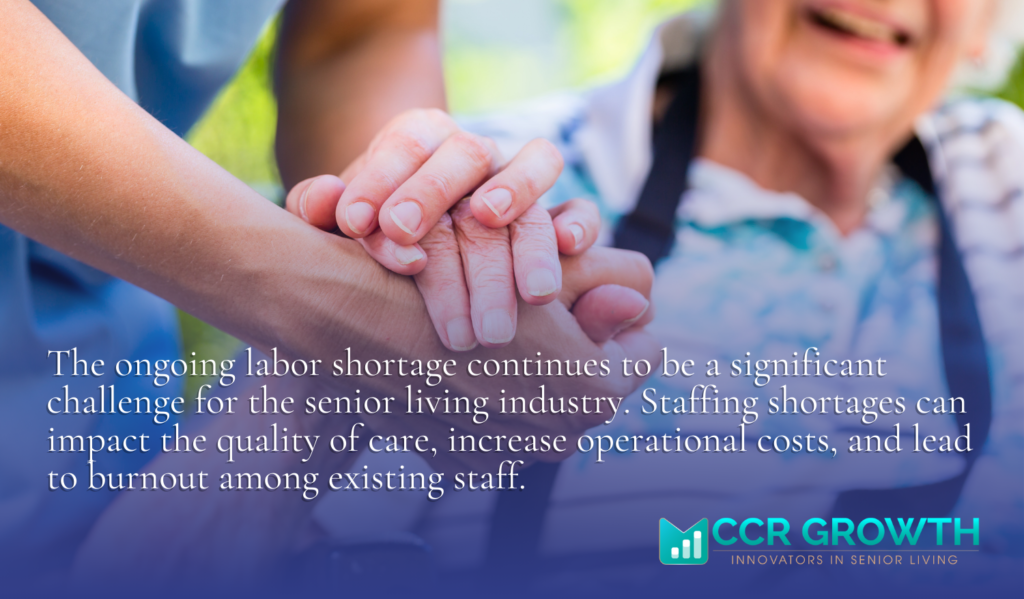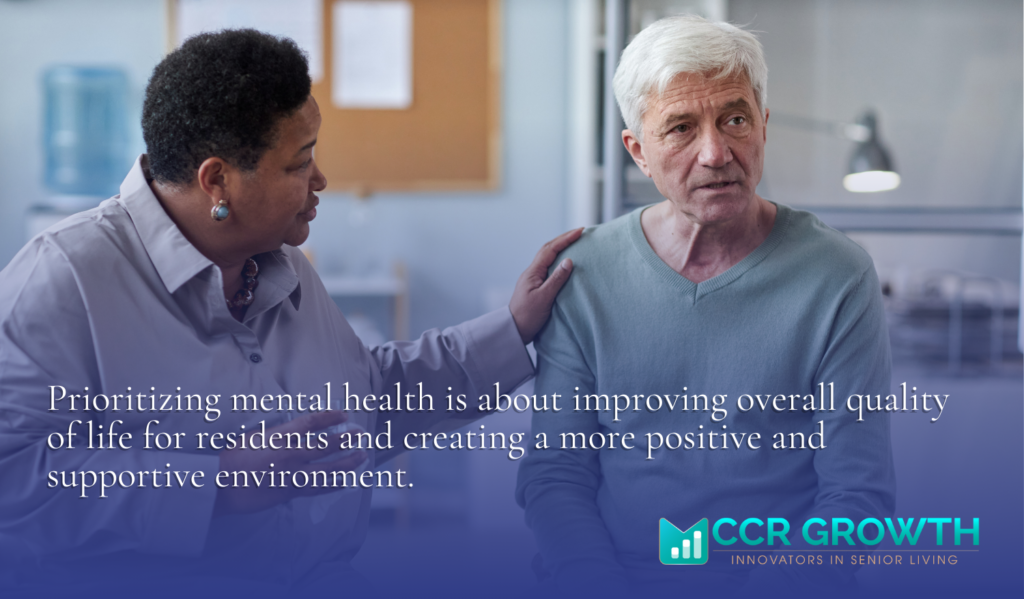
CCR Growth
10 Top Senior Living Insights from 2024
The past 12 months have seen a whirlwind of opportunities and challenges for senior living operators. Whether you specialize in assisted living communities, focus on the 55+ market or do a mix of both and more, there is so much wisdom to take away from 2024. It’s safe to say that the sector is experiencing a significant period of transformation that’ll continue well into the future.
So, as this year draws to a close, we’re asking ourselves how senior living communities can continue adapting to meet the changing demands of residents and their families, as well as the adjusted regulatory requirements, and the list goes on. In this article, we take a moment to look at the top senior living insights, challenges and developments we saw in 2024 to help providers to position themselves for success and ensure the well-being of their residents.

Outline
Published on
18/12/2024
1. Labor Shortages Persist
The ongoing labor shortage across all areas of healthcare, continues to be a significant challenge for the senior living industry. There’s no doubt that staffing shortages impact the quality of care, increase operational costs, and lead to burnout among existing staff. To address this issue, providers have been exploring innovative staffing models, offering competitive wages and benefits, and investing in employee training and development programs.
The U.S. Department of Health and Human Services issued a report in February 2024 acknowledging the significant staff losses and difficulties in hiring, training and retaining staff, still felt by the sector four years after the COVID-19 pandemic. Yet, the new minimum staffing standard now in place will likely make hiring competitive from the smaller pool of care professionals, not to mention retaining them for long-term care. The odds are stacked high, but senior living providers will need to rise to the challenge to find sustainable staffing solutions.

2. Workforce Development and Training
Attracting and retaining skilled workers is a critical challenge for the senior living industry. Investing in training and development programs can help ensure that staff have the skills and knowledge to provide high-quality care. The industry continues to grapple with staffing shortages and high turnover rates. Efforts to attract and retain qualified staff include offering competitive wages, professional development opportunities, and improving workplace culture to ensure consistent, high-quality resident care.
3. Rising Costs of Care
The staffing challenge also plays into the rising cost of care. It’s a major concern for both residents and providers. Inflation, increased regulatory requirements, and the rising cost of labor are contributing factors. To mitigate these challenges, providers may need to adjust pricing strategies, explore value-based pricing models, and seek innovative financing solutions. As the industry consolidates, with larger corporations acquiring smaller, family-owned communities, there are concerns about the potential impact on quality of care.
Prioritizing profits over the well-being of residents could lead to decreased staffing levels, reduced amenities, and a decline in the overall resident experience. It’s crucial for providers to balance financial sustainability with compassionate care.
4. Aging Population and Changing Demographics

The aging population and changing demographic trends are driving increased demand for senior living services. As the number of older adults grows, there is a need for a wider range of housing options, including specialized care for individuals with dementia and other chronic conditions. To meet these evolving needs, providers must adapt their offerings and target specific demographics. Added to this, today’s older adults are seeking more personalized and flexible living arrangements, with a preference for communities that offer a continuum of care, wellness programs, and social engagement opportunities. Operators are adapting to these preferences to remain competitive and meet the expectations of a new generation of residents.
5. Technology and Innovation
Technology is transforming the senior living industry, enabling providers to improve efficiency, enhance resident care, and enhance the overall living experience. The adoption of AI, Internet of Things, and telehealth solutions is gaining momentum, offering opportunities for personalized care, remote monitoring, and predictive analytics. Technology may offer some relief to staff members by performing more menial tasks, thereby allowing staff to focus on giving community members one-on-one care to enhance quality of life.
6. Regulatory Changes and Compliance
The senior living industry is subject to a complex regulatory environment. Changes in regulations can impact operations, staffing, and financial performance. Of course, staying informed about regulatory updates and ensuring compliance is essential for providers and requires them to stay adaptable. Areas of focus have been resident rights, safety protocols, and quality of care standards, with non-compliance potentially resulting in legal and financial repercussions. For example, there has been a growing call for federal oversight of assisted living facilities, which might mean stricter regulations leading to associated compliance costs.
7. Mental Health and Well-being

The importance of mental health and well-being has become increasingly recognized in the senior living industry. Providers are focusing on offering programs and services to support residents’ mental health, such as counseling, social activities, and wellness initiatives that reduce the risk of depression, anxiety, and other mental health issues. By prioritizing mental health, senior living communities can enhance the overall quality of life for residents and create a more positive and supportive environment.
8. Sustainability and Environmental Responsibility
As environmental concerns grow, senior living communities are adopting sustainable practices to reduce their carbon footprint and conserve resources. This includes energy-efficient building designs, renewable energy sources, and waste reduction initiatives. A heavier emphasis on efficient design and construction can also help to address financial challenges.
Developers are focusing on efficient design and construction practices, including modular builds and repeatable layouts. These strategies aim to reduce construction time and costs, enhancing project viability in a tight financial environment.
9. Economic Uncertainty
Economic uncertainty can impact the senior living industry, affecting occupancy rates, investment decisions, and consumer confidence. Providers must be prepared to adapt to changing economic conditions and implement strategies to mitigate risk.
It’s important to note that the industry is facing heightened financial challenges, with a rise in Chapter 11 bankruptcy filings. Factors contributing to this distress include high construction costs, elevated interest rates, and lending uncertainties, prompting operators to seek more efficient design and construction methods mentioned above to mitigate financial pressures.
10. Data Privacy and Cybersecurity
Protecting sensitive resident information must be a top priority for senior living providers. Implementing robust cybersecurity measures and staying informed about data privacy regulations is essential. This includes educating both staff and residents to be more technically literate. Running tech classes, or offering access to IT professionals, are just some of the ways senior living operators can ensure each person is keeping data safe.
Taking the time to understand and address these insights from 2024, senior living providers can position themselves for future success. Through prioritizing quality of care, financial sustainability, and innovation, the senior living industry can continue to provide essential services to older adults and their families.
With expertise in senior living marketing, sales, and business systems, our team at CCR Growth can help you optimize your operations, enhance resident experiences, and drive sustainable growth. Let’s work together to shape the future of senior living.
Subscribe to our newsletter
Sharpen your expertise and stay ahead of senior living industry trends—subscribe to CCR Growth’s newsletter for exclusive insights and updates.
Recent Posts


What is Nursing Home SEO: Benefits, Drawbacks, and Strategies

Build Your Brand from the Inside Out: A Senior Living Team Guide
Redefining Senior Living Marketing, Sales, and Operations
CONTACT ADDRESS
8710 Carmel Valley Road, Carmel, CA 93923
GENERAL INQUIRIES
info@ccrgrowth.com
(831) 273-3628
SOCIAL MEDIA




